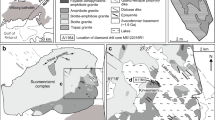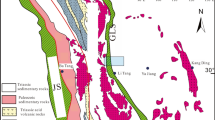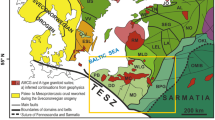Abstract
Episyenite is a quartz-depleted vuggy rock resulting from hydrothermal alteration of granitic rocks. This is the first report of its existence in an island arc, which is identified in a deep drill core of the Toki Cretaceous granite distributed in central Japan. In order to understand the petrographical features of the episyenite, neutron porosity measurement, geochemical analysis, microscopic observation, and X-ray computed tomography scanning were carried out. The results show remarkably high porosity (35.4 %) due to interconnecting vugs and the removal of quartz, plagioclase, and biotite. The Rb–Sr isotopic results and the paragenetic sequence of secondary minerals in the vugs suggest that the hydrothermal alteration process can be divided into an episyenitization stage and a later hydrothermal stage. At the episyenitization stage (70.6 ± 3.1 Ma) ca. 6 million years after the emplacement of the unaltered granite (76.3 ± 1.5 Ma), dissolution of quartz, biotite, and plagioclase occurred and was followed by the precipitation of albite, vermicular chlorite, and platy calcite. The episyenitization is considered as a local alteration of the Toki granite in an isotopically closed system. At the later hydrothermal stage, illite and secondary quartz precipitated from circulating meteoric-derived water in the dissolution vugs. Superimposing alteration at the later hydrothermal stage is limited, which results in the preservation of the episyenite in an almost primitive condition.







Similar content being viewed by others
References
Asahara Y, Ishiguro H, Tanaka T, Yamamoto K, Mimura K, Minami M, Yoshida H (2006) Application of Sr isotopes to geochemical mapping and provenance analysis: the case of Aichi Prefecture, central Japan. Appl Geochem 21:419–436
Asamori K, Niwa M, Hanamuro T, Yamada K, Kusano T, Makuuchi A, Takatori R, Saito-Kokubu Y, Matsubara A, Ishimaru R, and Umeda K (2012) Annual Report for Research on Geosphere Stability for Long-Term Isolation of Radioactive Waste in Fiscal Years 2011, JAEA-Review 2011-045. Tono Geoscientific Research Unit. Geological Isolation Research and Development Directorate, Japan Atomic Energy Agency
Baria R, Baumgärtnera J, Rummelb F, Pinec RJ, Sato Y (1999) HDR/HWR reservoirs: concepts, understanding and creation. Geothermics 28:533–552
Borges R, Villas R, Fuzikawa K (2009) Phase separation, fluid mixing, and origin of the greisens and potassic episyenite associated with the Água Boa pluton, Pitinga tin province, Amazonian Craton, Brazil. J S Am Earth Sci 27:161–183
Browne PRL (1978) Hydrothermal alteration in active geothermal fields. Annu Rev Earth Planet Sci 6:229–250
Cathelineau M (1986) The hydrothermal alkali metasomatism effects on granitic rocks: quartz dissolution and related subsolidus changes. J Petrol 27:945–965
Cathelineau M, Nieva D (1985) A chlorite solid solution geothermometer. The Los Azufres (Mexico) geothermal system. Contrib Mineral Petrol 91:235–244
Charoy B, Pollard PJ (1989) Albite-rich, silica-depleted metasomatic rocks at Emuford, Northeast Queensland; mineralogical, geochemical, and fluid inclusion constraints on hydrothermal evolution and tin mineralization. Econ Geol 84:1850–1874
Costi HT, Dall’Agnol R, Borges RMK, Minuzzi ORR, Teixeira JT (2002) Tin-bearing sodic episyenites associated with the Proterozoic, a-type agua boa granite, pitinga mine, amazonian craton, Brazil. Gondwana Res 5:435–451
Dempsey CS, Meighan IG, Fallick AE (1990) Desilication of Caledonian granites in the barnesmore complex, Co., donegal: the origin and significance of metasomatic syenite bodies. Geol J 25:371–380
Fournier RO (1991) The transition from hydrostatic to greater than hydrostatic fluid pressure in presently active continental hydrothermal systems in crystalline rock. Geophys Res Lett 18:955–958
Gonzàlez-Casado JM, Caballero JM, Casquet C, Galindo C, Tornos F (1996) Palaeostress and geotectonic interpretation of the Alpine cycle onset in the Sierra del Guadarrama (eastern Iberian Central System), based on evidence from episyenites. Tecnophysics 262:213–229
Grant JA (1986) The isocon diagram: a simple solution to Gresens’ equation for metasomatic alteration. Econ Geol 81:1976–1982
Harayama S (1992) Youngest exposed granitoid pluton on Earth: cooling and rapid uplift of the pliocene-quaternary takidani granodiorite in the Japan Alps, central Japan. Geology 20:657–660
Hayba DO, Ingebritsen SE (1997) Multiphase groundwater flow near cooling plutons. J Geophys Res 102:12235–12252
Hecht L, Thuro K, Plinninger R, Cuney M (1999) Mineralogical and geochemical characteristics of hydrothermal alteration and episyenitization in the Königshain granites, northern Bohemian Massif, Germany. Int J Earth Sci 88:236–252
Hosokawa Y, Ozawa S, Nakazawa H, Nakayama Y (1997) An x-ray guide tube and a desk-top scanning x-ray analytical microscope. X-Ray Spectrom 26:380–387
Ishihara S, Wu C (2001) Genesis of late cretaceous-paleogene granitoids with contrasting chemical trends in the Chubu district, central Japan. Bull Geol Sur Jpn 52:471–491
Ito H, Yamada R, Tamura A, Arai S, Horie K, Hokada T. (2013) Earth’s youngest exposed granite and its tectonic implications: the 10–0.8 Ma Kurobegawa Granite. Nature Scientific Reports 3, 1306
Itoigawa J (1980) Geology of the Mizunami district, central Japan. Monogr Mizunami Fossil Museum 1:1–50 (in Japanese)
Kameda J, Okamoto A, Mikouchi T, Kitagawa R, Kogure T (2010) The occurrence and structure of vermiform chlorite. Clay Sci 14:155–161
Kawada K, Yamada N, Isomi H, Murayama M, Katada M (1961) Geology of Japanese Central Alps and its western area (2) The Nohi rhyolites. Chikyu-Kagaku 54:20–31 (in Japanese with English abstract)
Koshiya S, Okami K, Hayasaka Y, Uzawa M, Kikuchi Y, Hirayama T, Doi N (1994) On the hydrothermal mineral veins developed in the Takinoue geothermal area, Northeast Honshu, Japan. J Geotherm Res Soc Jpn 16:1–24 (in Japanese with English abstract)
Leroy J (1978) The Margnac and Fancy uranium deposits of the La Crouzille district (western Massif Central, France); geologic and fluid inclusion studies. Econ Geol 73:1611–1634
Liu L, Suto Y, Bignall G, Yamasaki N, Hashida T (2003) CO2 injection to granite and sandstone in experimental rock/hot water systems. Energy Convers Manag 44:1399–1410
McDougall I, Harrison TM (1988) Geochronology and thermochronology by the 40Ar/39Ar method. Oxford University Press, New York, p 212
Nishimoto S, Yoshida H (2010) Hydrothermal alteration of deep fractured granite: effect of dissolution and precipitation. Lithos 115:153–162
Nishimoto S, Ukai E, Amano K, Yoshida H (2008) Alteration process in deep granitic rock - An example of Toki Granite, Central Japan. J Jpn Soc Eng Geol 49:94–104 (in Japanese with English abstract)
Petersson J, Whitehouse MJ, Eliasson T (2001) Ion microprobe U-Pb dating of hydrothermal xenotime from an episyenite: evidence for rift-related reactivation. Chem Geol 175:703–712
Petersson J, Stephens MB, Mattsson H, Moller C (2012) Albitization and quartz dissolution in Paleoproterozoic metagranite, central Sweden: implications for the disposal of spent nuclear fuel in a deep geological repository. Lithos 148:10–26
Poty B, Leroy J, Cathelineau M, Cuney M, Friedrich M, Lespinasse M, Turpin L (1986) Uranium deposits spatially related to granites in the French part of the Hercynian orogen. Vein type uranium deposits. IAEA, Vienna, pp 215–241
Recio C, Fallick AE, Ugidos JM, Stephens WE (1997) Characterization of multiple fluid-granite interaction processes in the episyenites of Avila-Bejar, Central Iberian Massif, Spain. Chem Geol 143:127–144
Rossi M, Rolland Y, Vidal O, Cox SF (2005) Geochemical variations and element transfer during shear zone development and related episyenites at middle crust depths: insights from the study of the Mont Blanc Granite (French-Italian Alps). In: Bruhn, D. and Burlini, L. (eds) High-strain zones: structure and physical properties. Geological Society of London Special Publications 245: 373–396
Sasaki M, Fujimoto K, Sawaki T, Sukamoto H, Kato O, Komatasu R, Doi N (2003a) Petrographic features of a high-temperature granite just newly solidified magma at the Kakkonda geothermal field, Japan. Journal of Volcanology and Geothermal Research 121: 247–269
Sasaki M, Fujimoto K, Tsukamoto H, Sawaki T, Sasada M, Kurosawa M, Yagi M, Muramatsu Y, Kato O, Komatsu R, Kasai K, Doi N (2003b) Geochemical features of vein anhydrite from the Kakkonda geothermal system, Northeast Japan. Res Geol 53:127–142
Savage D, Bateman K, Milodowski AE, Hughes CR (1993) An experimental evaluation of the reaction of granite with stream water, seawater and NaCl solutions at 200°C. J Volcanol Geoth Res 57:167–191
Schoch AE, Scheepers R (1990) The distribution of uranium and thorium in the cape columbine granite from the southwestern cape province, South Africa Original Research Article. Ore Geol Rev 5:223–246
Scott AM, Watanabe Y (1998) “Extreme boiling” model for variable salinity of Hokko low-sulfidation epithermal Au prospect, southwestern Hokkaido, Japan. Miner Deposita 33:568–578
Shibata K, Ishihara S (1979) Initial 87Sr/86Sr ratios of plutonic rocks from Japan. Contrib Mineral Petrol 70:381–390
Shibata K, Mizutani S (1982) Isotopic ages of Jurassic siliceous shale and Triassic bedded chert in Unuma, central Japan. Geochem J 16:213–223
Simmons SF, Christenson BW (1994) Origins of calcite in a boiling geothermal system. Am J Sci 294:361–400
Snelling AA, Woodmorappe J (1998) The cooling of thick igneous bodies on a young Earth, Proceedings of the Fourth International Conference on Creationism. In RE Walsh (ed.), Creation Science Fellowship, Pittsburgh, Pennsylvania, pp. 527–545
Sonehara T, Harayama S (2007) Petrology of the Nohi Rhyolite and its related granitoids: a late cretaceous large silicic igneous field in central Japan. J Volcanol Geoth Res 167:57–80
Suto Y, Liua L, Yamasaki N, Hashida T (2007) Initial behavior of granite in response to injection of CO2-saturated fluid. Appl Geochem 22:202–218
Suzuki K, Adachi M (1998) Denudation history of the high T/P Ryoke metamorphic belt, southwest Japan: constraints from CHIME monazite ages of gneisses and granitoids. J Metamorph Geol 16:23–37
Takagi H, Miwa S, Yokomizo Y, Nishijima K, Enjoji M, Mizuno T, Amano K (2008) Estimation of the pale stress field from the 3-D orientation distribution of microcracks and their geothermal conditions in the Toki Granite, central Japan. J Geol Soc Jpn 114:21–335
Theodore TG, Blair WN, Nash JT, McKee EH, Antweiler JC, Campbell WL (1987) Geology and gold mineralization of the Gold Basin-Lost Basin mining districts, Mohave County, Arizona, with a section on K-Ar chronology of mineralization and igneous activity, and a section on implications of the compositions of lode and placer gold. United States Geological Survey USGS Professional Paper #1361
Tornos F, Delgado A, Casquet C, Galindo C (2000) 300 Million years of episodic hydrothermal activity: stable isotope evidence from hydrothermal rocks of the Eastern Iberian Central System. Miner Deposita 35:551–569
Tsuruta T, Fujita Y, Abumi K, Mie H and Fujishiro H (2005) The DH-15 borehole investigations in the regional hydrogeological study project. Technical Report (TN7400 2005-025), Japan Nuclear Cycle Development Institute. (in Japanese with English abstract)
Tulloch AJ (1982) Mineralogical observations on carbonate scaling in geothermal wells at Kawerau and Broadlands. Proceedings 4th New Zealand Geothermal Workshop, p. 131–134
Turpin L, Cuney M, Friedrich M, Bouchez J, Aubertin M (1990a) Meta-igneous origin of Hercynian peraluminous granites in N. W. French Massif Central: implications for crustal history reconstructions. Contrib Mineral Petrol 104:163–172
Turpin L, Leroy J, Sheppard SMF (1990b) Isotopic systematics (O, H, C, Sr, Nd) of superimposed barren and U-bearing hydrothermal systems in a Hercynian granite, Massif Central, France. Chem Geol 88:85–98
Wakita K (2000) Melanges of the Mino terrane. Geol Soc Jpn Mem 55:145–163 (in Japanese with English abstract)
Yamada N, Wakita K, Hiroshima T, Komazawa T (1990) Geology of the Iida district. With Geological Sheet Map at 1:200,000. Geol Surv Jpn (in Japanese with English abstract)
Yamada N, Shibata K, Tsukada E, Uchiumi S, Matsumoto T, Takagi H, Akahane H (1992) Radiometric ages of igneous rocks around the Atera fault, central Japan, with special reference to the age of activity of the Atera Fault. Bull Geol Surv Japan 43:759–779
Yamasaki S, Umeda K (2012) Cooling history of the cretaceous Toki granite in the eastern Sanyo Belt, Central Japan. Jpn Mag Mineral Petrol Sci 41:39–46
Yamashita N, Kasuno Y, Itoigawa J (1988) Japanese geology 5 Chubu district II. Kyoritsu shuppan, Tokyo (in Japanese)
Yoshida H, Metcalfe R, Seida Y, Takahashi H, Kikuchi T (2009) Retardation capacity of altered granitic rock distributed along fractured and faulted zones in the orogenic belt of Japan. Eng Geol 106:116–122
Yoshida H, Metcalfe R, Ishibashi M, Minami M (2013) Long-term stability of fracture systems and their behaviour as flow paths in uplifting granitic rocks from the Japanese orogenic field. Geofluids 13:44–55. doi:10.1111/gfl.12008
Yuguchi T, Tsuruta T, Nishiyama T (2010) Zoning of rock facies and chemical composition in the Toki granitic body, Central Japan. Jpn Mag Mineral Petrol Sci 39:50–70
Yuguchi T, Tsuruta T, Nishiyama T (2011a) Three-dimensional cooling pattern of a granitic pluton, 2; The Study of deuteric sub-solidus reactions in the Toki granite, Central Japan. J Mineral Petrol Sci 106:130–141
Yuguchi T, Amano K, Tsuruta T, Danhara T (2011b) Thermochronology and the three-dimensional cooling pattern of a granitic pluton: an example from the Toki granite, Central Japan. Contrib Mineral Petrol 162:1063–1077
Yuguchi T, Tsuruta T, Hama K, Nishiyama T (2013) The Spatial variation of initial 87Sr/86Sr ratios in the Toki granite, Central Japan; Implications for the intrusion and cooling processes of a granitic pluton. J Mineral Petrol Sci 108:1–12
Acknowledgments
We wish to thank Professors K. Yamamoto and M. Takeuchi of Nagoya University for providing the valuable discussion. Mr. S. Yogo and Ms. M. Nozaki of Nagoya University Museum and Dr. Y. Yamamoto and Mr. T. Matsuzaki of Kochi University are acknowledged for their technical assistance. We are also grateful to Mr. C.O. Villanueva for his assistance during the preparation of the paper.
Author information
Authors and Affiliations
Corresponding author
Additional information
Communicated by J. Hoefs.
Rights and permissions
About this article
Cite this article
Nishimoto, S., Yoshida, H., Asahara, Y. et al. Episyenite formation in the Toki granite, central Japan. Contrib Mineral Petrol 167, 960 (2014). https://doi.org/10.1007/s00410-013-0960-8
Received:
Accepted:
Published:
DOI: https://doi.org/10.1007/s00410-013-0960-8




